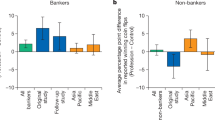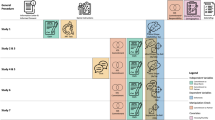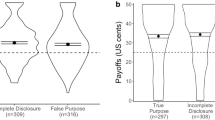Abstract
Trust in others’ honesty is a key component of the long-term performance of firms, industries, and even whole countries1,2,3,4. However, in recent years, numerous scandals involving fraud have undermined confidence in the financial industry5,6,7. Contemporary commentators have attributed these scandals to the financial sector’s business culture8,9,10, but no scientific evidence supports this claim. Here we show that employees of a large, international bank behave, on average, honestly in a control condition. However, when their professional identity as bank employees is rendered salient, a significant proportion of them become dishonest. This effect is specific to bank employees because control experiments with employees from other industries and with students show that they do not become more dishonest when their professional identity or bank-related items are rendered salient. Our results thus suggest that the prevailing business culture in the banking industry weakens and undermines the honesty norm, implying that measures to re-establish an honest culture are very important.
This is a preview of subscription content, access via your institution
Access options
Subscribe to this journal
Receive 51 print issues and online access
$199.00 per year
only $3.90 per issue
Buy this article
- Purchase on Springer Link
- Instant access to full article PDF
Prices may be subject to local taxes which are calculated during checkout



Similar content being viewed by others
References
Algan, Y. & Cahuc, P. Trust and growth. Annu. Rev. Econ. 5, 521–549 (2013)
Ariely, D. The (Honest) Truth About Dishonesty: How We Lie To Everyone—Especially Ourselves (Harper, 2012)
Coricelli, G., Joffily, M., Montmarquette, C. & Villeval, M. C. Cheating, emotions, and rationality: an experiment on tax evasion. Exp. Econ. 13, 226–247 (2010)
Pruckner, G. J. & Sausgruber, R. Honesty on the streets: a field study on newspaper purchasing. J. Eur. Econ. Assoc. 11, 661–679 (2013)
Kantšukov, M. & Medvedskaja, D. From dishonesty to disaster: the reasons and consequences of rogue traders’ fraudulent behavior. Adv. Ser. Manag. 10, 147–165 (2013)
Abrantes-Metz, R. M., Kraten, M., Metz, A. D. & Seow, G. S. Libor manipulation? J. Bank. Finance 36, 136–150 (2012)
Sapienza, P. & Zingales, L. A trust crisis. Int. Rev. Finance 12, 123–131 (2012)
Salz, A. The Salz Review: An Independent Review of Barclays’ Business Practices (Barclays, 2013)
Hill, C. A. & Painter, R. The Personal and Professional Responsibility of Investment Bankers (Univ. of Minnesota Law School, 2012)
Moshinsky, B. Turner Makes Claim for BOE Job as Bank Culture Reform Sought http://www.bloomberg.com/news/2012-07-24/turner-stakes-claim-for-boe-helm-as-bank-culture-reform-sought.html (Bloomberg, 2012)
Levine, R. Financial development and economic growth: views and agenda. J. Econ. Lit. 35, 688–726 (1997)
Hill, C. A. Bankers behaving badly? The limits of regulatory reform. Rev. Bank. Financ. Law 31, 675–691 (2012)
Akerlof, G. A. & Kranton, R. E. Identity Economics: How Our Identities Shape Our Work, Wages, and Well-Being (Princeton Univ. Press, 2010)
Benjamin, D. J., Choi, J. J. & Strickland, A. J. Social Identity and preferences. Am. Econ. Rev. 100, 1913–1928 (2010)
Shih, M., Pittinsky, T. L. & Ambady, N. Stereotype susceptibility: identity salience and shifts in quantitative performance. Psychol. Sci. 10, 80–83 (1999)
LeBoeuf, R. A., Shafir, E. & Bayuk, J. B. The conflicting choices of alternating selves. Organ. Behav. Hum. Decis. Process. 111, 48–61 (2010)
Cohn, A., Maréchal, M. A. & Noll, T. Bad Boys: How Criminal Identity Affects Rule Violation http://ideas.repec.org/p/zur/econwp/132.html (Ideas, 2013)
Bucciol, A. & Piovesan, M. Luck or cheating? A field experiment on honesty with children. J. Econ. Psychol. 32, 73–78 (2011)
Houser, D., Vetter, S. & Winter, J. Fairness and cheating. Eur. Econ. Rev. 56, 1645–1655 (2012)
Fischbacher, U. & Föllmi-Heusi, F. Lies in disguise—an experimental study on cheating. J. Eur. Econ. Assoc. 11, 525–547 (2013)
Mazar, N., Amir, O. & Ariely, D. The dishonesty of honest people: a theory of self-concept maintenance. J. Mark. Res. 45, 633–644 (2008)
Shalvi, S., Eldar, O. & Bereby-Meyer, Y. Honesty requires time (and lack of justifications). Psychol. Sci. 23, 1264–1270 (2012)
Ohtsubo, Y., Masuda, F., Watanabe, E. & Masuchi, A. Dishonesty invites costly third-party punishment. Evol. Hum. Behav. 31, 259–264 (2010)
Bicchieri, C. The Grammar of Society: The Nature and Dynamics of Social Norms (Cambridge Univ. Press, 2006)
Smith, G. Why I left Goldman Sachs: A Wall Street Story (Grand Central Publishing, 2012)
Das, S. Traders, Guns & Money: Knowns and Unknowns in the Dazzling World of Derivatives (Financial Times/Prentice Hall, 2010)
Vohs, K. D., Mead, N. L. & Goode, M. R. The psychological consequences of money. Science 314, 1154–1156 (2006)
Boatright, J. R. Swearing to be virtuous: the prospects of a banker’s oath. Rev. Soc. Econ. 71, 140–165 (2013)
Quinn, J. HSBC Chairman Urges Bankers to Swear an Oath http://www.telegraph.co.uk/finance/newsbysector/banksandfinance/9700776/HSBC-Chairman-urges-bankers-to-swear-an-oath.html (2012)
Shu, L. L., Mazar, N., Gino, F., Ariely, D. & Bazerman, M. H. Signing at the beginning makes ethics salient and decreases dishonest self-reports in comparison to signing at the end. Proc. Natl Acad. Sci. USA 109, 15197–15200 (2012)
Acknowledgements
We thank the participating bank, the alumni network organizations of three education programmes, and the municipal office for enabling the research; G. Akerlof and D. Ariely for critical discussions; C. Efferson, T. Herz and S. Gschwend for reading of the manuscript; and D. Bigliel and M. Brunner for research assistance. Financial support from the European Research Council Grant “Foundations of Economic Preferences” and the Gottlieb Duttweiler Institute is gratefully acknowledged.
Author information
Authors and Affiliations
Contributions
A.C. and M.A.M. developed the research idea; A.C., E.F. and M.A.M. designed the study; A.C. and M.A.M. conducted the experiments, and analysed data. A.C., E.F. and M.A.M. wrote the manuscript.
Corresponding authors
Ethics declarations
Competing interests
The authors declare no competing financial interests.
Extended data figures and tables
Extended Data Figure 1 The impact of professional identity on bank employees’ intrinsic competitiveness.
Competitiveness is measured by the bank employees’ answers to the question “How important is it to you to be the best at what you do?” on a scale from 1 (not at all important) to 7 (very important). We find no significant difference in competitiveness between the professional identity and the control condition (P = 0.861, two-sided rank-sum test, n = 128). Error bars indicate s.e.m.
Extended Data Figure 2 Bank employees’ beliefs about other bank employees’ percentage of successful coin flips.
Incentivized belief elicitation experiment with bank employees. The professional identity condition had no significant influence on beliefs (P = 0.921, two-sided rank-sum test, n = 142). Error bars indicate s.e.m.
Extended Data Figure 3 Distribution of earnings in the coin tossing task claimed by the non-banking employees.
a, b, Each successful coin toss yielded approximately $20. a, Distribution of earnings in the control condition and binomial distribution (implied by honest reporting). b, Distribution of earnings in the professional identity condition and binomial distribution. The rate of successful coin flips is 55.8% (12% misreporting) in the professional identity condition, and 59.8% (20% misreporting) in the control condition, which is not significantly different (P = 0.128, two-sided rank-sum test, n = 133).
Extended Data Figure 4 Distribution of earnings in the coin tossing task claimed by the students.
a, b, Each successful coin toss yielded approximately $5. a, Distribution of earnings in the control condition and binomial distribution (implied by honest reporting). b, Distribution of earnings in the banking condition and binomial distribution. The rate of successful coin flips is 57.9% (16% misreporting) in the control condition and 56.4% (13% misreporting) in the banking condition, which is not significantly different (P = 0.390, two-sided rank-sum test, n = 222).
Extended Data Figure 5 Gallup survey of honesty standards of people in the banking industry.
Fraction of US citizens thinking that bankers have very low or low honesty or ethical standards from 1977 to 2013. This graph is an interpretation of data compiled by Gallup, Inc. However, Gallup, Inc. had no part in the creation of this graphic interpretation.
Supplementary information
Supplementary Information
This file contains Supplementary Methods, Supplementary Analysis, Supplementary Robustness Checks, Supplementary Materials, Supplementary Tables 1-8 and additional references. (PDF 1014 kb)
Rights and permissions
About this article
Cite this article
Cohn, A., Fehr, E. & Maréchal, M. Business culture and dishonesty in the banking industry. Nature 516, 86–89 (2014). https://doi.org/10.1038/nature13977
Received:
Accepted:
Published:
Issue Date:
DOI: https://doi.org/10.1038/nature13977
This article is cited by
-
Formal Ethics, Content Ethics and Relational Ethics: Three Approaches to Constructing Ethical Sales Cultures and Identities in Retail Banking
Journal of Business Ethics (2024)
-
Groups versus individuals, partial lying, and social image concern in a dice-rolling experiment
The Japanese Economic Review (2024)
-
Do Wealth Managers Understand Codes of Conduct and Their Ethical Dilemmas? Lessons from an Online Survey
Journal of Business Ethics (2024)
-
Suspicious minds and views of fairness
Theory and Decision (2024)
-
Who Keeps Company with the Wolf will Learn to Howl: Does Local Corruption Culture Affect Financial Adviser Misconduct?
Journal of Business Ethics (2024)
Comments
By submitting a comment you agree to abide by our Terms and Community Guidelines. If you find something abusive or that does not comply with our terms or guidelines please flag it as inappropriate.



